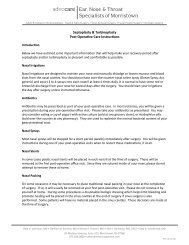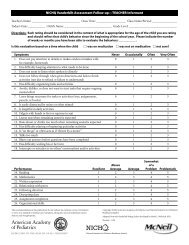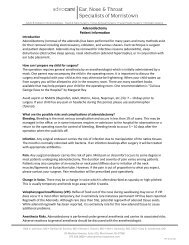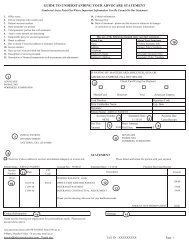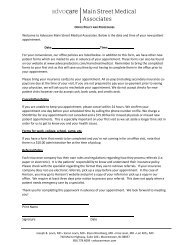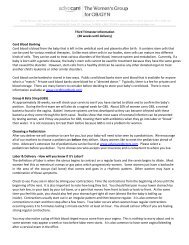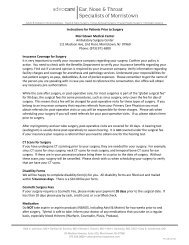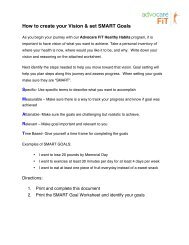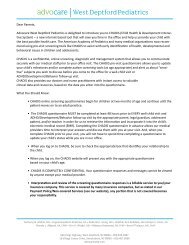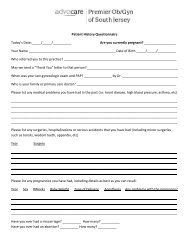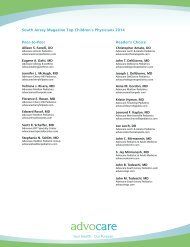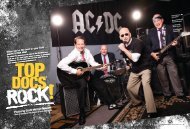Septoplasty & Turbinoplasty Patient Information - Advocare
Septoplasty & Turbinoplasty Patient Information - Advocare
Septoplasty & Turbinoplasty Patient Information - Advocare
Create successful ePaper yourself
Turn your PDF publications into a flip-book with our unique Google optimized e-Paper software.
Adult & Pediatric Otolaryngology - Head & Neck Surgery • Sinus & Nasal Surgery • Facial Plastic Surgery • Otologic Surgery<br />
Introduction to <strong>Septoplasty</strong> & <strong>Turbinoplasty</strong><br />
<strong>Septoplasty</strong> (Septum Straightening) &<br />
<strong>Turbinoplasty</strong> (Inferior Turbinate Reduction)<br />
<strong>Patient</strong> <strong>Information</strong><br />
The nasal turbinates are paired bony structures (inferior, middle, and superior) that exist on each side<br />
of the lateral nasal wall in all patients. The inferior turbinates are designed as sausage-like swellings<br />
within each nasal cavity. As a result of their positioning or swelling they may interfere with nasal<br />
airflow and contribute to the sensation of nasal obstruction. They normally act to humidify and warm<br />
the air that we breathe.<br />
The lining (mucosa) of the inferior turbinate bone shrinks and swells as part of the normal nasal cycle.<br />
In most people this rhythmic cycle goes largely unnoticed. However, in some patients swelling of the<br />
tissue may reach a threshold that causes a decrease in the nasal airflow, and hence, leads to the<br />
sensation of nasal obstruction. This lining may also become periodically swollen due to allergy or<br />
infection. In addition, the underlying bone may be large or positioned within the nasal cavity and<br />
further contribute to nasal obstructive symptoms.<br />
The nasal septum is the natural partition that divides the nasal cavities into left and right sides. <strong>Septoplasty</strong><br />
is a surgical procedure designed to realign the septum in the midline to improve nasal airflow<br />
and decrease nasal obstruction.<br />
Everyone has a nasal septum. Some are deviated since birth due to birth trauma (congenital), while<br />
others develop a deviation as the result of facial or nasal trauma (acquired). No matter the cause, a<br />
deviated septum is one of many reasons why a patient may have difficulty breathing through their<br />
nose, and hence, have the sensation of nasal obstruction. Usually nasal obstruction due to a deviated<br />
septum is unilateral (one-sided) as the septum is deviated to either the left or right side. However, in<br />
some instances a patient may have a complex septal deviation that limits airflow through both nostrils.<br />
How will I be evaluated and when are <strong>Septoplasty</strong> and/or <strong>Turbinoplasty</strong> indicated?<br />
The decision to proceed with septoplasty and/or turbinoplasty is usually reserved for patients with<br />
nasal obstruction due to inferior turbinate hypertrophy (large inferior turbinates) or a deviated septum.<br />
However, many patients have inferior turbinate hypertophy or a deviated septum without any sensation<br />
of nasal obstruction and thus do not require surgical correction. It is also important to distinguish<br />
that septoplasty and turbinoplasty are not sinus surgery.<br />
In a majority of patients with nasal obstruction and inferior turbinate hypertrophy and/or septal<br />
deviation a trial of topical nasal steroids will be attempted prior to surgery. Additional testing and<br />
treatment, such as, CT scans, nasal endoscopy, medications for sinusitis, and possibly allergy testing<br />
may be required depending upon a patient’s individual history and exam findings. Once it is determined<br />
that medical therapy has been ineffective at bringing significant relief of symptoms, it is appropriate<br />
to discuss septoplasty and/or turbinoplasty as an option.<br />
Reid A. Lachman, MD • Damian W. Sorvino, MD • Renato J. Giacchi, MD • Seth J. Kanowitz, MD, FACS • Sara B. Immerman, MD<br />
95 Madison Avenue, Suite 105, Morristown, NJ 07960<br />
973.644.0808 • advocaremorristownent.com<br />
PH 12 (4/12)
What will happen in the operating room?<br />
All septoplasty and turbinoplasty procedures are performed under general anesthesia, and thus the<br />
surgery is typically well tolerated and not uncomfortable. The surgery will begin once the anesthesiologist<br />
has administered the anesthetic medications.<br />
The surgical plan will be discussed in the office during your pre-operative visit; however, intra-operative<br />
findings may require adjustments to the surgical plan to help maximize your results. Everything possible<br />
is done to help anticipate these adjustments in advance of your surgery. However, certain decisions can<br />
only be made at the time of surgery.<br />
The surgery is performed using nasal instruments inserted though the nostrils without any facial<br />
incisions. The nasal endoscope, a small camera, and endoscopic instruments may also be employed.<br />
Key areas of inferior turbinate swelling are removed and/or reduced. The septum is realigned near the<br />
midline and areas of deviated cartilage and bone are removed. The surgery does not change the shape<br />
of your nose and should not routinely cause bruising around the eyes. The procedure usually takes 90<br />
minutes.<br />
In some patients plastic nasal stents are placed in the nasal cavity at the completion of surgery. These<br />
stents are sutured in place and should not be removed by the patient. The decision to use stents is<br />
made depending upon intra-operative findings. Nasal stents are not considered nasal packing.<br />
On some occasions it may be necessary to place traditional nasal packing in your nose at the completion<br />
of surgery. If so, it will usually be removed at your first post-operative visit. Again, this decision is made<br />
at the time of surgery.<br />
How do I prepare for <strong>Septoplasty</strong> and/or <strong>Turbinoplasty</strong>?<br />
• A history and physical exam will be performed. If chronic medical conditions exist, a letter of medical<br />
clearance will be requested from your primary medical physician.<br />
• Blood work, chest X-ray, EKG, and other tests may be required depending on your health.<br />
• A recent CT scan of the sinuses may be obtained and reviewed.<br />
• Do not eat or drink anything after midnight the night before surgery. If you are taking medication,<br />
please ask during your pre-operative visit if these pills may be taken the morning of surgery.<br />
• Do not take aspirin or salicylate containing medications for at least 10 – 14 days prior to surgery.<br />
These medications increase the risk of bleeding.<br />
• Do not take non-steroidal anti-inflammatory (NSAIDS) medications (i.e. Ibuprofen, Advil, Motrin,<br />
Aleve, naprosyn, etc.) for at least 7 days prior to your surgery. These medications increase the risk of<br />
bleeding. It is okay to take Tylenol (acetaminophen) as needed for headache or pain.<br />
• If you are taking blood thinners (Aspirin, Plavix, Coumadin, Lovenox, etc.), on the recommendations of<br />
a physician, ask if they will need to be stopped in advance of your surgery. The timing of this should<br />
be discussed with your surgeon and the prescribing medical physician.<br />
• Do not take any supplements or herbal remedies that may increase your risk of bleeding (Garlic,<br />
Vitamin E, Ginkgo, Ginger, Sal Palmetto, etc.) for at least 7 days prior to your surgery.<br />
• Avoid alcoholic beverages 7 days prior to your surgery. Alcohol is dehydrating and increases your risk<br />
of bleeding.<br />
• Avoid cigarette smoking. If you smoke, please do your best to quit or at least significantly limit your<br />
cigarette usage 2 to 3 weeks prior to your surgery. Tobacco smoke is known to increase the risk of<br />
anesthesia and may adversely affect post-operative healing.
What are the possible risks and complications of <strong>Septoplasty</strong> and/or <strong>Turbinoplasty</strong>?<br />
• Bleeding<br />
The risk of significant bleeding during septoplasty and/or turbinoplasty is very low. Significant<br />
bleeding may require termination of the procedure, nasal packing, and/or hospitalization. A blood<br />
transfusion is very rarely necessary. Minor bleeding (oozing) for a few days after the surgery is considered<br />
normal.<br />
• Infection<br />
Any surgical endeavor carries the risk of infection due to manipulation of the native tissues. If an<br />
infection develops after surgery it will be treated with appropriate antibiotics.<br />
• Nasal Crusting and Dryness<br />
As a result of reshaping the contour of the inferior turbinates and/or nasal septum your new pattern<br />
of nasal airflow may make you prone to nasal crusting and dryness. This is usually treated with<br />
short-term nasal irrigations and moisturizers, but in rare cases may be required lifelong.<br />
• Septal Perforation (for <strong>Septoplasty</strong> only)<br />
In very rare occasions a patient may develop a small hole in the repaired septum. This may lead to<br />
chronic crusting, bleeding, nasal whistling, and in some cases, the paradoxical sensation of nasal<br />
obstruction. This may require additional surgical procedures to correct or lifelong use of nasal saline<br />
and/or nasal moisturizers.<br />
• Anesthesia risks<br />
<strong>Turbinoplasty</strong> and <strong>Septoplasty</strong> are performed under general anesthesia and carry its associated risks.<br />
Adverse reactions to general anesthesia should be discussed with the anesthesiologist.<br />
• Change in voice<br />
This may be due to change in airflow through your nose after the surgery which affects the quality<br />
and character of your voice.<br />
• Temporary swelling or bruising around the eye<br />
These rare symptoms are usually temporary, but in some patients, they may be permanent.<br />
• Need for additional surgical or medical interventions<br />
Additional surgical procedures may be necessary in the future to help maximize your long-term<br />
results. Each patient’s individual healing process cannot be predicted in advance, and the severity of<br />
chronic rhinosinusitis differs from patient to patient.<br />
What will happen after my surgery?<br />
<strong>Septoplasty</strong> and/or turbinoplasty procedures are performed on an out-patient basis. If other significant<br />
medical conditions exist additional hospitalization time may be required.<br />
You will have some mild bloody or brownish discharge from your nose for 1 to 2 weeks after surgery.<br />
Furthermore, your nasal obstruction may get temporarily worse after surgery as the nasal cavity naturally<br />
swells after surgery. This is normal and improves over time. You will not be able to blow your nose<br />
rigorously or perform strenuous activity, heavy lifting, or bending over for 2 weeks after surgery. Consequently<br />
time off from work may be necessary. You will be given prescription pain medication and a<br />
short course of antibiotics. Most patients tolerate the surgery and post-operative recovery very well as<br />
the surgery and healing is not particularly painful.




